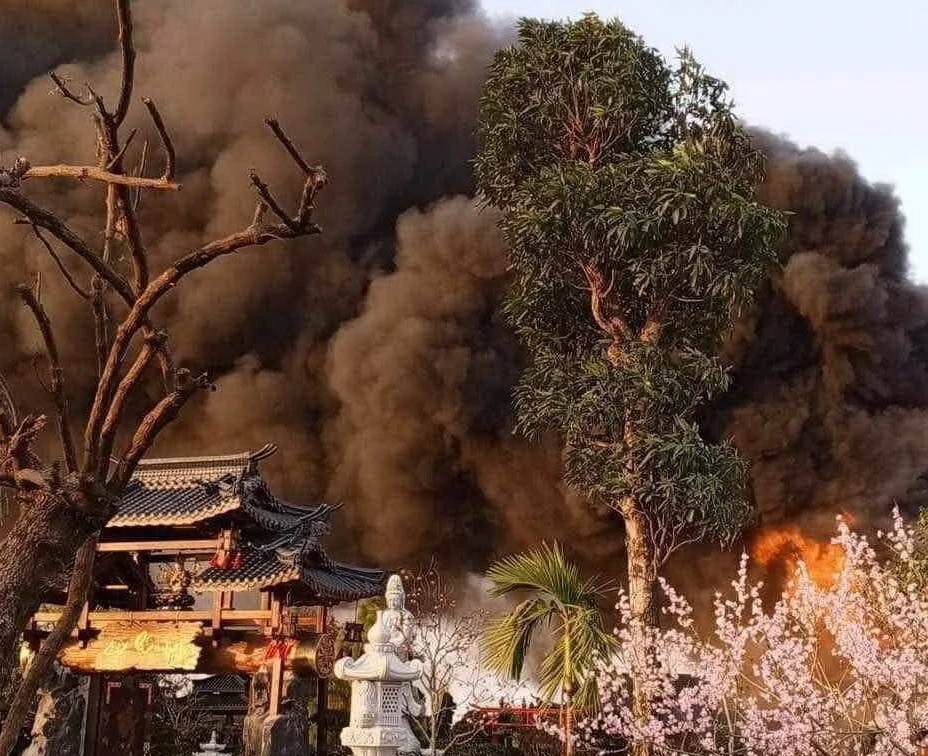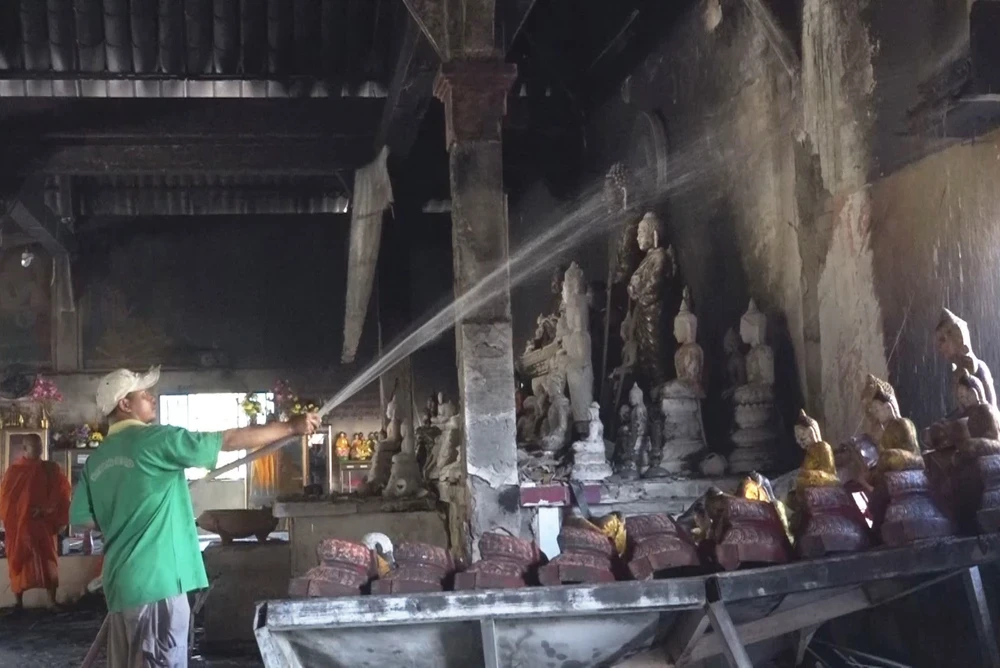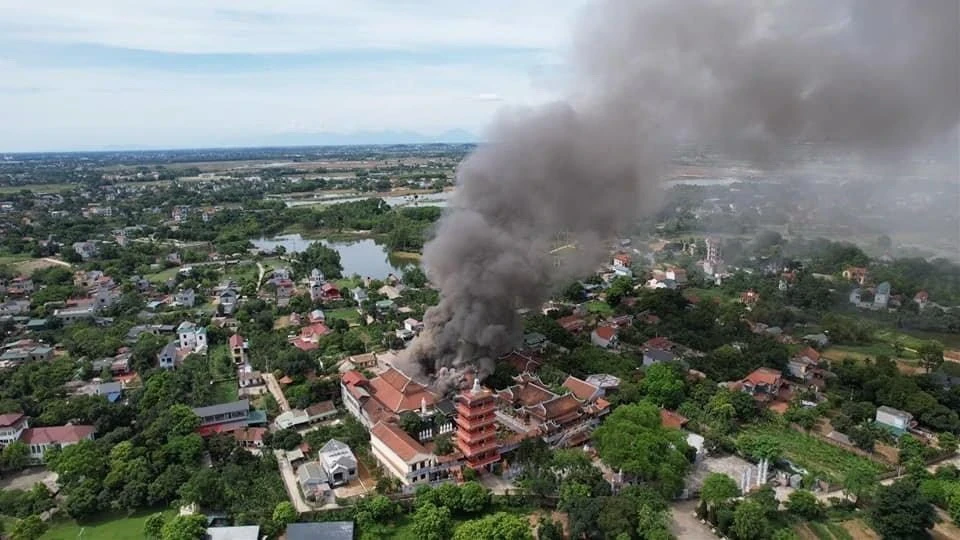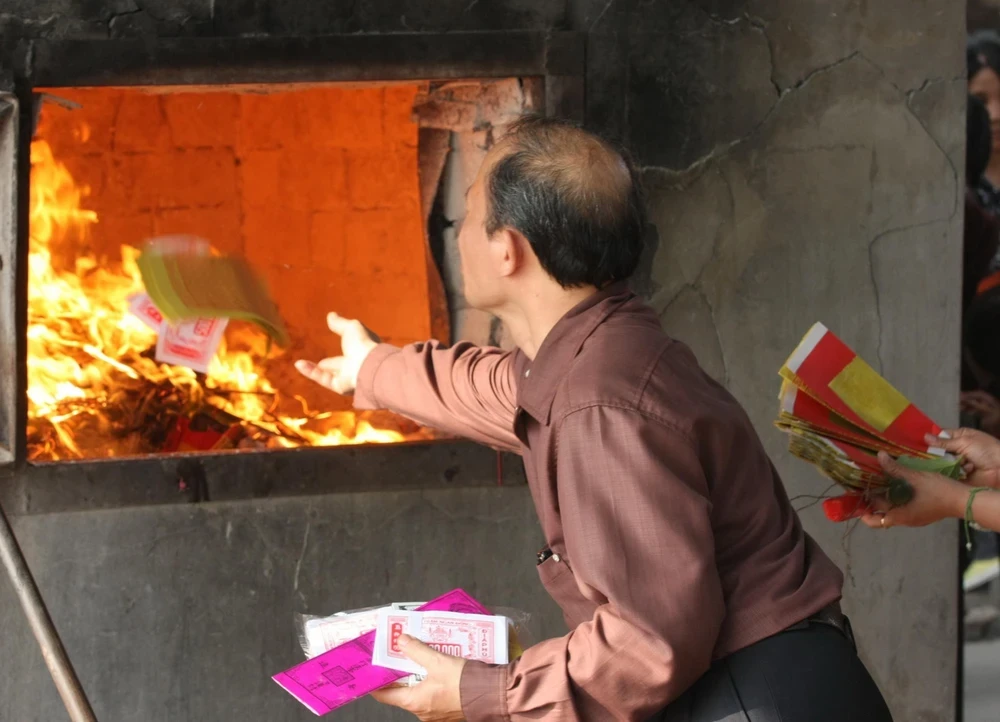The recent fire at Phat Quang Pagoda, Thanh Phong Commune, Thanh Liem District (Ha Nam) is a warning bell about the risk of fire and explosion at temples, pagodas, spiritual establishments..., especially as Tet approaches.

Visiting temples, pagodas and pagodas during holidays and Tet is a habit in the spiritual and cultural life of Vietnamese people. However, burning incense and candles in large quantities, not regularly checking the electrical system, and lacking awareness of complying with fire safety regulations... at these locations can potentially pose a risk of fire and explosion.
Recently, at 4:40 p.m. on January 20, a fire broke out in the lecture hall of Phat Quang Pagoda, Thanh Phong Commune, Thanh Liem District, Ha Nam Province.
The lecture hall area is about 200m2, built with cement brick walls with plastic panels, about 4.5m high, covered with corrugated iron roof, surrounded by walls covered with flammable materials. The lecture hall has many equipment such as amplifiers, speakers, air conditioners, tables and chairs, computers, books and 5 statues.
The fire burned the Tu An house and the artifacts inside, leaving only the frame, causing an estimated loss of 500-600 million VND.
The initial cause of the fire was determined to be an electrical short circuit.
Previously, in July 2019, a major fire broke out at Ta Bet Pagoda in Thanh Loc Commune, Chau Thanh District, Kien Giang Province. After more than an hour, the fire was brought under control.
About 150 large and small Buddha statues were burned along with many properties in the temple, causing an estimated loss of about 600 million VND. The cause of the fire was determined to be due to burning candles.

Surely many people have not forgotten the Tam Bao house of Linh Quang pagoda (Dong Thuong village, Dong Yen commune, Quoc Oai, Hanoi) with an area of over 200m2, built with 120m3 of ironwood worth more than tens of billions of VND, turned into charcoal after a fire at night in June 2020.
The fire at Cu Da Pagoda (Da Ton Commune, Gia Lam, Hanoi) in January 2020 was also a regrettable case because this is an ancient pagoda built during the Le Dynasty, 300 years old, and was ranked as a National Monument in 1996.
The fire caused the roof of the Upper Palace to collapse, the wooden structures, rafters and worshiping system in the Tam Bao Palace to be completely charred, causing tens of billions of dong in damage.

In June 2022, a fire suddenly broke out at the Tu An house construction site at Hoa Phuc pagoda (Quoc Oai district, Hanoi), burning down 7 traditional Northern wooden houses.
To proactively prevent possible fire and explosion situations, especially before, during and after holidays and Tet, local fire prevention and rescue police forces have stepped up propaganda and guidance on fire and explosion safety regulations in spiritual areas such as temples, pagodas and joss paper shops.
To ensure fire prevention and fighting safety, people also need to raise awareness of prevention and strictly comply with regulations on fire safety.

Authorities recommend that Management Boards and people in charge of religious establishments... increase propaganda and improve fire prevention and fighting knowledge for those serving at temples, pagodas as well as visitors and tourists.
The Management Board and the person in charge of the religious establishment shall promulgate regulations and rules on fire prevention and fighting; and prepare conditions for escape in case of fire.
Management Boards and persons in charge of religious establishments and religious facilities must regularly inspect electrical systems, electrical equipment, lighting, and electrical wires.
Temples and pagodas must have storage facilities to ensure fire safety for incense, candles, and votive paper; incense and lamp holders must be securely and permanently arranged; there must be a place to destroy incense, lamps, and votive paper... The Management Board must assign someone to watch over visitors when they come to burn incense and candles to immediately handle any careless cases.
The Management Board of spiritual facilities must not leave materials or goods; must not allow people to trade on walkways, railings, corridors, doors, or escape routes; must proactively equip fire prevention and fighting equipment, and regularly inspect and maintain existing fire prevention and fighting equipment, ensuring that the equipment operates properly in the event of a fire.
The altar must be made of fire-resistant or non-flammable materials and have a partition to prevent fire from spreading to the surrounding area. It is necessary to strictly manage fire sources, heat sources, fire-generating and heat-generating equipment and tools in the kitchen area, main hall, warehouse, parking lot, etc.
Management Boards and persons in charge of religious establishments shall organize training for on-site fire fighting forces on the use of fire extinguishers and escape conditions; and minimize the use of incense, candles, and votive paper.
HA (according to Vietnam+)